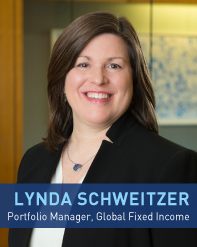
On Friday, March 13, Loomis Sayles’ Global Fixed Income Team held a conference call to discuss the current market environment, policy responses and potential opportunities. Here, portfolio managers Lynda Schweitzer and Scott Service summarized a few key points.
The big picture
 “It doesn't happen often that a single event or shock could so quickly alter our view of the global economy and impact markets such as we've seen over the last couple of months with the global spread of the coronavirus. We have seen market moves like this before: 9/11, the Russian default/Long-Term Capital Management (LTCM) crisis in 1998 and the global financial crisis. Those were also periods of panic and uncertainty, but when we get through the worst and the dust settles, there will be opportunities.
“It doesn't happen often that a single event or shock could so quickly alter our view of the global economy and impact markets such as we've seen over the last couple of months with the global spread of the coronavirus. We have seen market moves like this before: 9/11, the Russian default/Long-Term Capital Management (LTCM) crisis in 1998 and the global financial crisis. Those were also periods of panic and uncertainty, but when we get through the worst and the dust settles, there will be opportunities.
We were looking forward to 2020 being a period where we could potentially add in opportunities as we got the confirmation of a rebound in global growth. Now that's changed. The virus on its own is enough to alter that view, but now it is combined with the supply shock in oil that we saw when Russia and Saudi Arabia decided to flood the market with oil. Both events together comprise a dramatic deflationary shock.
As more quarantines are put in place, we expect that global growth estimates will be revised down. We expect supply chain disruptions from the shutdowns which will impact manufacturing, which was just starting to recover. More importantly, the consumer and services will be impacted. Right now, we do not believe the US will enter a recession, but the odds have certainly risen. Once the quarantines stop, we expect a recovery in the US. We expect at least one quarter of negative growth in the second quarter and sluggish positive growth in the third quarter. Much of this depends on how long the various quarantines and shutdowns last, so our view of US and global growth will be fluid and changing.
Monetary and fiscal actions
We expect that central banks will continue to step in and help support the market. We have seen multiple countries cut rates in response to both the slowdown and some of the market instability and volatility. Our base case is that the Fed will go to the zero lower bound probably next week at their meeting, but certainly by the beginning of the second quarter. The support by central banks is a good confidence builder for the market, but we think there is a recognition of the limits of monetary policy.
(Post-call update: on Sunday, March 15, the Federal Reserve slashed its benchmark interest rate to near zero and launched a bond-buying program of $500 billion in Treasury securities and $200 billion in mortgage-backed securities).
We have seen good fiscal support with multiple countries announcing stimulus. We expect a package here in the US that will continue to support global growth. Even in Europe where they have been very anti-fiscal stimulus, we've seen some softening and expect that there will be some support enacted.
US Treasury market
We have seen unusually tough liquidity within the Treasury market, which is noteworthy and unusual. We are seeing widening bid/ask spreads, an inability to trade in any size and it is even impacting the corporate market because corporates price off Treasurys. There’s always something that is unusual about these market panics and in this case, the Treasury illiquidity is something new.
- Lynda Schweitzer, Portfolio Manager and Co-Head, Global Fixed Income Team
Credit markets

We are seeing spreads widen rapidly in a short period of time. To put this into context, we’re seeing negative returns of minus 7-9% across credit markets, which basically wipes out all of the positive excess returns that we experienced in 2019. Looking at historical spread ranges, we are pricing a two-thirds chance of a recession.
In addition to the virus, we have the oil price war. The Saudis and the Russians are upset with the US shale producers and all of the oil that they produce. They’re making a point here; oil is down 49% year to date. So we kind of have this perfect storm: the virus, the energy crisis and challenging liquidity across various spaces in credit and Treasurys. On an industry basis, energy is taking the brunt of the hit but we are also seeing broad-based pain across travel-impacted sectors.
Liquidity
Liquidity is generally difficult in both the secondary and new issue markets. Bid/ask spreads are significantly wider than average. We have spent a lot of time talking about this over the past few days and one of the funny things is there is good volume going through, but it is really ticker-specific. It is difficult to add broad-based risk in the market. You do have to remember that both buyside and sellside firms are dealing with staffing disruptions so it’s a bit more difficult than you would wish.
Risks and tailwinds
There are some big risks out there currently and there are also a few tailwinds as we go forward. Unfortunately it seems like we are just in the beginning stages of the virus here in the US, but thankfully industries – including small businesses, colleges and schools – are taking this very seriously and shutting down. That should help stem the spread of the virus going forward. From a credit market point of view, the big risk is getting a good grasp on the fundamental impact on companies going forward. It’s hard to forecast without knowing how long the shutdowns will be, but doing the fundamental credit research is important.
We have seen worse situations before. We would argue that 2008 was worse than what we are seeing now and we came out of that rather nicely. The key is to focus on company balance sheets, cash flows, and near-term liquidity, ignore all of the technicals, and buy into weakness. Banks are well-capitalized, household balance sheets are in good shape. We do not view it as a financial crisis like 2008.
The other big risk is the oil market. It’s important to note that energy makes up about 9% of the investment grade market and about 10% of the US high yield market. You could see contagion across credit markets as managers have outflows and have to sell. It might not just be energy that they have to sell.
We are also keeping our eye on the elections in the fall. We will have to wait and see how it plays out but policy changes are possible with a new president.
- Scott Service, Portfolio Manager and Co-Head, Global Fixed Income Team
MALR025062
Commodity, interest and derivative trading involves substantial risk of loss. This is not an offer of, or a solicitation of an offer for, any investment strategy or product. Any investment that has the possibility for profits also has the possibility of losses.
Performance data shown represents past performance and is no guarantee of, and not necessarily indicative of, future results.
Market conditions are extremely fluid and change frequently.
This blog post is provided for informational purposes only and should not be construed as investment advice. Any opinions or forecasts contained herein reflect the
subjective judgments and assumptions of the authors only and do not necessarily reflect the views of Loomis, Sayles & Company, L.P. Information, including
that obtained from outside sources, is believed to be correct, but Loomis Sayles cannot guarantee its accuracy. This material cannot be copied, reproduced or
redistributed without authorization. This information is subject to change at any time without notice.




